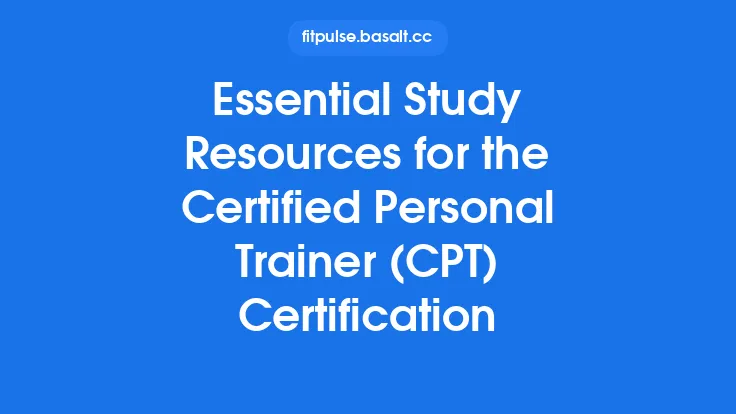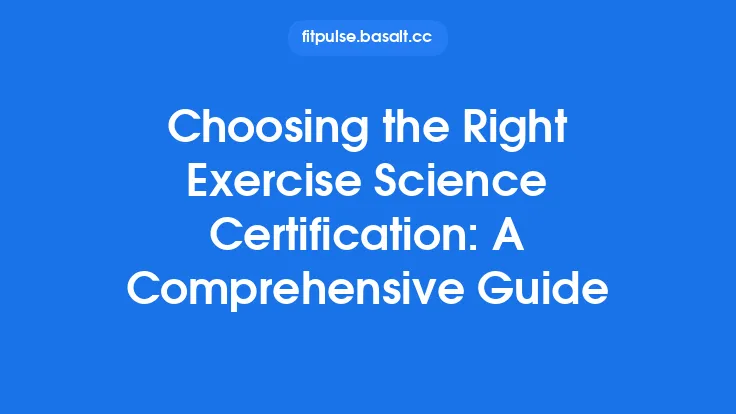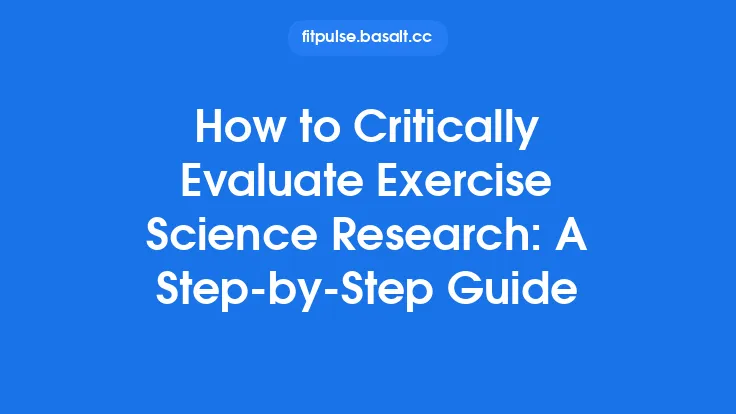Embarking on an exercise science certification exam is a significant milestone that demands more than just a casual review of textbook chapters. The key to success lies in constructing a personalized study plan that aligns with your unique learning style, professional responsibilities, and timeline. A well‑crafted plan not only maximizes knowledge retention but also reduces anxiety, improves efficiency, and ultimately boosts confidence on exam day. Below is a comprehensive, step‑by‑step framework for designing a study strategy that can be adapted to any major exercise science credential, whether you are pursuing a certification in strength and conditioning, clinical exercise physiology, or any other specialized area within the field.
1. Clarify the Exam Blueprint and Competency Domains
Before you allocate any study hours, obtain the official exam blueprint from the certifying organization. This document typically outlines:
| Domain | Approx. Weight (%) | Core Topics |
|---|---|---|
| Foundations of Exercise Science | 15 | Anatomy, physiology, biomechanics |
| Assessment & Testing | 20 | Fitness testing protocols, data interpretation |
| Program Design & Implementation | 25 | Periodization, exercise prescription |
| Safety, Ethics, & Professional Practice | 15 | Risk management, legal considerations |
| Nutrition & Supplementation | 10 | Energy systems, macronutrient timing |
| Research & Evidence‑Based Practice | 15 | Study design, critical appraisal |
Map each domain to the specific sub‑topics listed in the blueprint. This mapping becomes the skeleton of your study plan, ensuring you allocate proportionate time to high‑weight areas while still covering lower‑weight content.
2. Conduct a Self‑Assessment to Identify Knowledge Gaps
A realistic self‑audit prevents wasted effort on material you already master. Use one of the following methods:
- Diagnostic Quiz: Many certifying bodies provide a free sample test. Score it and note the domains where you scored below 70 %.
- Concept‑Mapping: Create a mind map of all topics. Highlight nodes you feel uncertain about.
- Peer Review: Discuss key concepts with a study partner or mentor; ask them to quiz you on areas you claim confidence in.
Document the results in a spreadsheet, assigning a “gap score” (0–5) for each sub‑topic. This quantitative approach will later guide your weekly study focus.
3. Set SMART Goals and a Realistic Timeline
Transform the raw data from your self‑assessment into actionable objectives using the SMART framework:
- Specific: “Complete the biomechanics section, focusing on joint kinematics, by week 3.”
- Measurable: “Score ≥ 85 % on weekly practice quizzes for the assessment domain.”
- Achievable: Align goals with your work schedule; if you work 40 h/week, allocate 10–12 h for study.
- Relevant: Prioritize domains with the highest exam weight or those where you have the largest gap.
- Time‑Bound: Set a clear deadline, e.g., “Finish all primary content review by 30 days before the exam.”
Plot these goals on a Gantt chart or calendar, marking milestones such as “first full‑length practice exam” and “final content review.”
4. Choose Study Materials Aligned with Your Learning Style
Not all resources are created equal, and the most effective ones match your preferred mode of information processing:
| Learning Style | Recommended Resources |
|---|---|
| Visual | High‑resolution anatomy atlases, infographics, video lectures (e.g., YouTube channels with peer‑reviewed content) |
| Auditory | Podcasts on exercise physiology, recorded webinars, narrated slide decks |
| Kinesthetic | Hands‑on lab simulations, case‑study workshops, interactive software (e.g., biomechanics modeling tools) |
| Reading/Writing | Textbooks, peer‑reviewed journal articles, detailed study guides, flashcard decks (Anki) |
Select a primary textbook that mirrors the exam’s content outline, then supplement it with at least one alternative format for each major domain. Ensure all resources are up‑to‑date (preferably within the last 3 years) to reflect current scientific consensus.
5. Structure Weekly Study Sessions Using the Pomodoro Technique
Consistent, focused study blocks improve retention and reduce mental fatigue. A proven schedule looks like this:
- Pre‑Study Ritual (5 min) – Review goals for the session, gather materials, and eliminate distractions.
- Pomodoro Cycle (25 min) – Deep work on a single sub‑topic (e.g., “muscle fiber type recruitment”).
- Short Break (5 min) – Stretch, hydrate, or perform a brief mindfulness exercise.
- Repeat – Complete 4 cycles, then take a longer break (15–30 min).
During each Pomodoro, employ active learning strategies: write summary notes, create concept maps, or teach the material aloud to an imaginary audience. After the session, log what you covered and rate your confidence on a 1–5 scale; this data feeds back into your gap‑score spreadsheet.
6. Integrate Retrieval Practice and Spaced Repetition
Research consistently shows that recalling information strengthens memory more than passive rereading. Implement the following:
- Flashcards: Use a spaced‑repetition platform (e.g., Anki) to create cards for definitions, formulas, and protocol steps. Tag cards by domain for targeted review.
- Self‑Generated Questions: After each study block, write 3–5 questions that could appear on the exam. Answer them without notes after a 24‑hour interval.
- Weekly Cumulative Quizzes: Compile a 30‑question quiz covering all topics studied that week. Analyze errors to adjust upcoming focus areas.
Spaced repetition algorithms automatically increase intervals for cards you answer correctly, ensuring you revisit difficult concepts just before they are at risk of being forgotten.
7. Simulate Exam Conditions with Full‑Length Practice Tests
A single practice exam is not enough; you need multiple simulations to build stamina and refine test‑taking strategies.
- Baseline Test: Take a timed, full‑length practice exam at the start of your study plan. Use this as a benchmark for progress.
- Mid‑Point Test: Schedule a second full test after you have completed the primary content review (approximately 50 % of the total study period).
- Final Test: Conduct a third practice exam within the last week before the real test.
During each simulation, adhere strictly to the official time limits, use only the allowed calculator or reference materials, and sit in a quiet environment. After each test, perform a detailed item analysis:
- Identify patterns (e.g., consistently missing questions on energy system calculations).
- Calculate domain‑specific accuracy to see if any weighty sections still need reinforcement.
- Review rationales for both correct and incorrect answers to deepen conceptual understanding.
8. Optimize Physical and Mental Well‑Being
Your brain’s capacity to learn is directly linked to your overall health. Incorporate these habits into your study plan:
- Sleep Hygiene: Aim for 7–9 hours of quality sleep per night. Use a consistent bedtime routine and limit screen exposure 30 minutes before sleep.
- Exercise: Paradoxically, regular moderate‑intensity exercise (e.g., 30 minutes of brisk walking) enhances memory consolidation.
- Nutrition: Prioritize complex carbohydrates, lean protein, and omega‑3 fatty acids. Consider a modest caffeine dose (≈ 200 mg) before intense study blocks if tolerated.
- Stress Management: Practice brief mindfulness or breathing exercises (4‑7‑8 technique) during breaks to lower cortisol levels.
Tracking these variables in a simple habit‑tracker app can reveal correlations between lifestyle factors and study performance.
9. Review and Refine the Plan Weekly
A static plan quickly becomes obsolete as you progress. Allocate a 30‑minute “plan audit” at the end of each week:
- Update Gap Scores based on quiz results and self‑ratings.
- Adjust Time Allocation: If a domain’s gap score remains high, shift an extra Pomodoro from a lower‑priority area.
- Reflect on Study Techniques: Note which active‑learning methods yielded the best retention and double down on them.
- Set Next Week’s SMART Goals: Ensure they remain realistic given any changes in work or personal commitments.
Document these adjustments in a dedicated “Study Log” to maintain accountability and to provide a reference for future certification attempts, should the need arise.
10. Final Countdown: The Last Two Weeks
The final stretch is about consolidation rather than new learning.
| Day | Activity |
|---|---|
| 1–3 | Review high‑weight domains with flashcards; focus on weak items identified in the last practice test. |
| 4–5 | Re‑take the most recent full‑length practice exam under timed conditions. |
| 6 | Conduct a “brain dump” session: write out all key formulas, protocols, and definitions from memory. |
| 7 | Light review of notes; no new material. |
| 8–10 | Rest days with light physical activity, adequate sleep, and stress‑reduction techniques. |
| 11 | Final quick glance at the exam checklist (ID, testing center details, allowed materials). |
| 12 | Exam day – arrive early, hydrate, and employ breathing strategies before the test begins. |
During these two weeks, keep study sessions short (≤ 45 minutes) to avoid burnout. Trust the knowledge you have built; the goal is to keep the information fresh and accessible.
11. Post‑Exam Reflection and Future Learning
Regardless of the outcome, a structured debrief is valuable:
- Score Analysis: If results are released, compare actual performance to your predicted scores from practice tests.
- Identify Residual Gaps: Note any topics that still feel shaky; these become the focus of your continuing education plan.
- Celebrate Milestones: Acknowledge the discipline and effort invested; this reinforces positive study habits for future professional development.
By treating the certification journey as a cyclical learning process, you not only achieve the immediate credential but also lay a foundation for lifelong competence in exercise science.
Bottom Line
Developing a personal study plan for exercise science certification exams is a systematic endeavor that blends curriculum mapping, self‑assessment, goal setting, evidence‑based learning techniques, and wellness strategies. By following the step‑by‑step framework outlined above—and by continuously monitoring and adjusting your approach—you can transform a daunting exam into a manageable, confidence‑building experience. The result is not just a passing score, but a deeper, more integrated mastery of the science that will serve you throughout your professional career.





